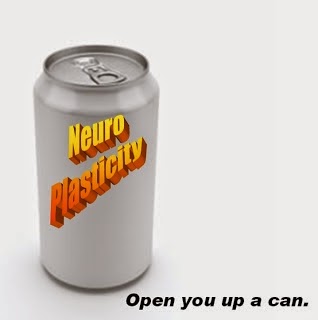 |
| Peter G. Levine Stronger After Stroke |
 There's this idea among many clinicians and survivors that when it comes to recovery it's all about neuroplasticity. Certainly, my book as well as many of my articles support this concept. But it's not 100% true. Some of recovery comes from stuff other than neuroplasticity.
There's this idea among many clinicians and survivors that when it comes to recovery it's all about neuroplasticity. Certainly, my book as well as many of my articles support this concept. But it's not 100% true. Some of recovery comes from stuff other than neuroplasticity.To explain this, let's nail down two things:
- What neuroplasticity is
- When neural plasticity is important
What is Neuroplasticity?
Neuroplasticity – the simplest definition: Changing the structure and/or function of neurons in the brain. Actually, this is not entirely true. Neuroplasticity can happen anywhere in the nervous system. Even peripheral nerves can change in terms of structure and function. This is why, when it comes to stroke, researchers often talk about "cortical plasticity." They are being very specific about where the plasticity is happening: in the cortex of the brain.
 The cortex is where all the neuron cell bodies are, and therefore where all the neuroplastic action is.
The cortex is where all the neuron cell bodies are, and therefore where all the neuroplastic action is.So very specifically the definition of neuroplasticity as a relates to stroke is this: Changing the structure and or function of neurons in the cortex of the brain.
Okay. We have neuroplasticity nailed down. Now let me nailed down when neuroplasticity is important after stroke.
When is Neuroplasticity Important?
The first thing to do is figure out when neuroplasticity is not that important. The cortex of the brain is constantly rewiring in all of us -- all of the time. But it is only robust enough to make a difference in a stroke survivor once they are chronic. The chronic phase is generally defined as "after the first three months after stroke." But probably a better way to define it is: the point after the plateau. So once a survivor has plateaued from then to the end of their life they are considered chronic.
During the chronic phase neuroplasticity is vitally important to recovery. It is only through forging new pathways a chronic stroke survivor learn to move better.
So neuroplasticity is vital to recovery during the chronic phase. And make no mistake: for most very successful stroke survivors who recover a lot the recovery done during the chronic phase is represents a huge part of their recovery.
However, most recovery, for most survivors happens during the subacute phase (from 7 days to 3 months, average). But during the subacute phase neuroplasticity, by and large, is not the predominant driver of recovery.
So what is the primary driver during the subacute phase?
To put it simply, recovery during the subacute phase has to do with "using the penumbra."
The penumbra is the portion of the brain that surrounds the area that was killed by the stroke. NOT using the whole penumbra is the essence of learned nonuse.
More about the penumbra and how to use it (all) in the next entry!
See the original article:
in


No comments:
Post a Comment